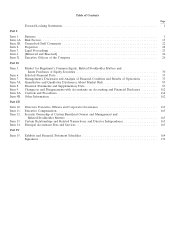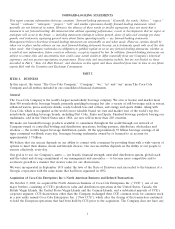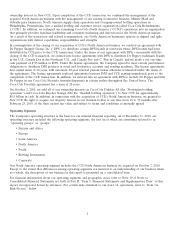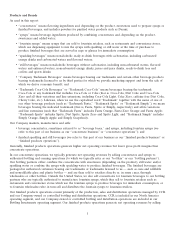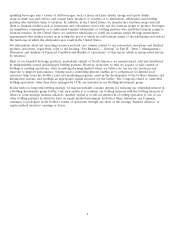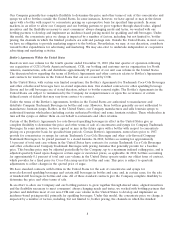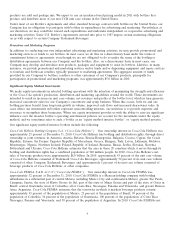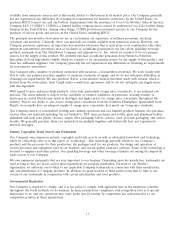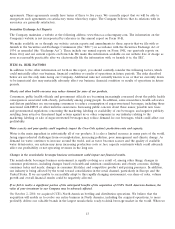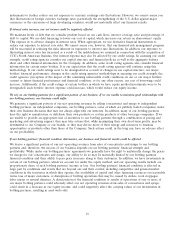Coca Cola 2010 Annual Report Download - page 8
Download and view the complete annual report
Please find page 8 of the 2010 Coca Cola annual report below. You can navigate through the pages in the report by either clicking on the pages listed below, or by using the keyword search tool below to find specific information within the annual report.Consumer demand determines the optimal menu of Company product offerings. Consumer demand can vary from one
locale to another and can change over time within a single locale. Employing our business strategy, and with special
focus on core brands, our Company seeks to build its existing brands and, at the same time, to broaden its historical
family of brands, products and services in order to create and satisfy consumer demand locale by locale.
During 2010, our Company introduced a variety of new brands, brand extensions and new beverage products. Among
numerous examples, in the Eurasia and Africa group, new launches included new flavors of Minute Maid juice and
juice drinks in India, including Minute Maid Nimbu Fresh; Maaza Milky Delite in India, a blend of mango and milk
and the Company’s first venture into dairy products in India; the reformulated Fanta in Russia with natural flavors and
colors, and no preservatives; and Dogadan ready-to-drink tea in Turkey. In the Latin America group we launched del
Valle Pulpy, a juice drink with real orange pulp, in Mexico; and Blak, an on-premise liquid coffee concentrate sold to
customers through a dispenser, also in Mexico. In the North America group, we introduced to consumers in the United
States glac´
eau vitaminwater zero, an extension of our popular glac´
eau vitaminwater products with zero calories per
serving; and Sokenbicha, a line of brewed unsweetened teas blended with natural botanicals, which are popular in
Japan. In the Europe group, new launches included Coca-Cola Zero Caffeine-Free in France, the first caffeine-free
variant of the Coca-Cola Zero brand sold in Europe; and Bonaqua Lemon Lime in the Czech Republic. In the Pacific
group, in China we launched Minute Maid 10 Score V, a juice drink fortified with vitamins, and, through BPW,
launched Yuan Ye, a new jasmine flavor variant of its ready-to-drink tea beverage; and we extended the footprint of
Minute Maid Pulpy, a juice drink with real bits of fruit pulp, with launches in Singapore and Malaysia.
In furtherance of our commitments to sustainability and innovation, during 2010 we expanded our launch of our
innovative PlantBottle packaging, a polyethylene terephthalate (‘‘PET’’) bottle made partially from plant-based material
that, like our existing PET bottles, is 100 percent recyclable. PlantBottle packaging was introduced in Japan, Mexico,
Brazil, Norway, Sweden, Chile and China (at the Shanghai Expo). Also in 2010, we expanded the footprint of our
innovative Coca-Cola Freestyle fountain dispenser to more than 400 customer locations across 20 markets in the United
States. Coca-Cola Freestyle provides consumers with a greater choice of brands, with more than 100 different regular
and low-calorie branded beverages, including a variety of still beverages.
We measure the volume of Company beverage products sold in two ways: (1) unit cases of finished products and
(2) concentrate sales. As used in this report, ‘‘unit case’’ means a unit of measurement equal to 192 U.S. fluid ounces
of finished beverage (24 eight-ounce servings); and ‘‘unit case volume’’ means the number of unit cases (or unit case
equivalents) of Company beverage products directly or indirectly sold by the Company and its bottling partners (the
‘‘Coca-Cola system’’) to customers. Unit case volume primarily consists of beverage products bearing Company
trademarks. Also included in unit case volume are certain products licensed to, or distributed by, our Company, and
brands owned by Coca-Cola system bottlers for which our Company provides marketing support and from the sale of
which we derive economic benefit. In addition, unit case volume includes sales by joint ventures in which the Company
has an equity interest. We believe unit case volume is one of the measures of the underlying strength of the Coca-Cola
system because it measures trends at the consumer level. The unit case volume numbers used in this report are derived
based on estimates received by the Company from its bottling partners and distributors. Concentrate sales volume
represents the amount of concentrates and syrups (in all cases expressed in equivalent unit cases) sold by, or used in
finished beverages sold by, the Company to its bottling partners or other customers. Unit case volume and concentrate
sales volume growth rates are not necessarily equal during any given period. Factors such as seasonality, bottlers’
inventory practices, supply point changes, timing of price increases, new product introductions and changes in product
mix can impact unit case volume and concentrate sales volume and can create differences between unit case volume
and concentrate sales volume growth rates. In addition to the items mentioned above, the impact of unit case volume
from certain joint ventures, in which the Company has an equity interest, but to which the Company does not sell
concentrates or syrups, may give rise to differences between unit case volume and concentrate sales volume growth
rates.
Distribution System and Bottler’s Agreements
We make our branded beverage products available to consumers in more than 200 countries through our network of
Company-owned or controlled bottling and distribution operations, bottling partners, distributors, wholesalers and
retailers — the world’s largest beverage distribution system. Consumers enjoy finished beverage products bearing our
trademarks at a rate of approximately 1.7 billion servings each day. We continue to expand our marketing presence and
increase our unit case volume in developed, developing and emerging markets. Our strong and stable system helps us to
6


